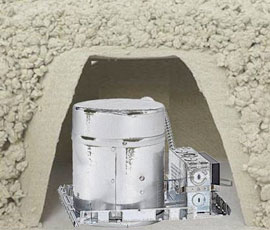 For the past couple decades homeowners have been eagerly installing recessed lighting. Fancy lighting can be sexy but it can also introduce many energy related problems. The big mistake most folks make is installing the wrong canned lights. The cheaper cans on the shelf at your local home improvement store are usually not the best option as they usually are not ICAT (insulation contact air tight) cans. If the attic is on the opposite side of the ceiling it is critical that these ICAT cans are used. Otherwise the following issues are introduced.
For the past couple decades homeowners have been eagerly installing recessed lighting. Fancy lighting can be sexy but it can also introduce many energy related problems. The big mistake most folks make is installing the wrong canned lights. The cheaper cans on the shelf at your local home improvement store are usually not the best option as they usually are not ICAT (insulation contact air tight) cans. If the attic is on the opposite side of the ceiling it is critical that these ICAT cans are used. Otherwise the following issues are introduced.
AIR INFILTRATION
Non-airtight cans are basically 4-6 inch holes in your ceiling. Since your house is generally under pressure, these non-airtight cans can be major sources of air infiltration, and air infiltration equals energy loss.
NO THERMAL BARRIER
Not only do non-airtight cans have zero insulation, but proper clearances to insulation should be met around the fixtures. Most manufacturers require a minimum of 3 inches clearances around the canned light. In order to meet this requirement the hole in your insulation can be 10-12 inches. With ICAT airtight cans, insulation can be blown over the fixture.
THE SOLUTIONS
Some do-it-yourselvers have been promoting the idea of building boxes around non-airtight cans to prevent air infiltration and thermal issues. This practice generally recommends that the non-airtight cans be covered with a boxes made from drywall or rigid insulation (attic side of course). This can be a good solution, but only if you are using compact florescent bulbs because they put off little heat. However, if you are using halogen or incandescent bulbs, the heat that is created can be trapped in this box, which can introduce heat concerns. I recently stumbled on a new solution that solves all the problems. It is a canned light cover that meets heat requirements, provides an air seal, and keeps the insulation back. These can cost around $25 per light compared to $100-$150 per light, with electrician fees. Check out Attic Dr. for more information.
